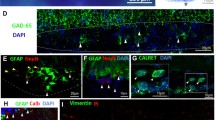Summary
Serial sagittal sections of the postnatally developing cerebellum of Wistar rats were studied to determine the incidence, origin, and relation to other cerebellar structures of nests of heterotopic cells. These nests were found to consist of small, darkly staining cells of either irregular or elongate shape with large, dark nuclei and bore close resemblance to cells of the external granular layer. They were present in every animal from the day of birth to at least day 15 of life and were confined to the uvula, nodulus, and pyramis of the vermis. In addition, the cell nests were found to be perivascular and continuous with the external granular layer via a narrow tongue of cells surrounding capillaries which penetrated to the medullary layer of the cerebellum from the subarachnoid space. The significance of the nests in relation to other studies, and their involution after day 15 of life is briefly considered.
Similar content being viewed by others
References
Addison, W. H. F.: The development of the Purkinje cells and of the cortical layers of the cerebellum of the albino rat. J. comp. Neurol.21, 459–487 (1911)
Alpers, B. J.: Diffuse progressive degeneration of the gray matter of the cerebrum. Arch. Neurol. Psychiat. (Chic.)25, 469–505 (1931)
Altman, J.: Autoradiographic and histological studies of postnatal neurogenesis. III. Dating the time of production and onset of differentiation of cerebellar microneurons in rats. J. comp. Neurol.136, 269–294 (1969)
Andreoli, J., Rodier, P., Langman, J.: The influence of a prenatal trauma on the formation of Purkinje cells. Amer. J. Anat.137, 87–102 (1973)
Bailey, O.: Medulloblastoma. In: Pathology of the nervous system, pp. 2071–2081. P. Minckler (Ed.). New York: McGraw-Hill 1968
Bailey, P., Cushing, H.: Medulloblastoma cerebelli. A common type of midcerebellar glioma of childhood. Arch. Neurol. Psychiat. (Chic.)14, 192–224 (1925)
Brun, R.: Zur Kenntnis der Bildungsfehler des Kleinhirns (Beitrag zur Entwicklungspathologie des Zentralnervensystems). Schweiz. Arch. Neurol. Psychiat.1, 61–123 (1917)
Brzustowicz, R. J., Kernohan, J. W.: Cell rests in the region of the fourth ventricle. III. Their relationship to the development of gliomas. Arch. Neurol. Psychiat. (Chic.)67, 602–611 (1952)
Friede, R.: Dating the development of human cerebellum. Acta neuropath. (Berl.)23, 48–58 (1973)
Innes, J. R. M., Borner, G.: Tumors of the central nervous system of rats: with report of two tumors of the spinal cord and comments on posterior paralysis. J. nat. Cancer Inst.26, 719–736 (1961)
Jellinger, K., Embryonal cell nests in human cerebellar nuclei. Z. Anat. Entwickl.-Gesch.138, 145–154 (1972)
Kershman, J.: The medulloblast and the medulloblastoma. Arch. Neurol. Psychiat. (Chic.)40, 937–967 (1938)
Korneliussen, H.: On the ontogenetic development of the cerebellum (nuclei, fissures, and cortex) of the rat, with special reference to regional variations in corticogenesis. J. Hirnforsch.10, 379–412 (1968)
Larsell, O.: The morphogenesis and adult pattern of the lobules and fissures of the cerebellum of the white rat. J. comp. Neurol.97, 281–356 (1952)
Miale, I., Sidman, R.: An autoradiographic analysis of histogenesis in the mouse cerebellum. Exp. Neurol.4, 277–296 (1961)
Raaf, J., Kernohan, J.: Relation of abnormal collections of cells in posterior medullary velum of cerebellum to origin of medulloblastoma. Arch. Neurol. Psychiat. (Chic.)52, 163–169 (1944)
Ranke, O.: Beiträge zur Kenntnis normaler und pathologischer Hirnrindenbildung. Beitr. path. Anat.47, 51 (1910)
Rorke, L., Riggs, H., Fogelson, M.: Cerebellar heterotopia in infancy. (Abstr.) J. Neuropath. exp. Neurol.27, 140 (1968)
Schaper, A.: Einige kritische Bemerkungen zu Lugaro's Aufsatz: Über die Histogenese des Körner der Kleinhirnrinde. Anat. Anz.10, 422–426 (1895)
Schenk, V. W. D.: Minor dysgenetic cells and cell groups in the perinatal cerebellum. Neuropat. pol.11, 173–181 (1973)
Stevenson, L., Echlin, F.: Nature and origin of some tumors of the cerebellum. Arch. Neurol. Psychiat. (Chic.)31, 93–109 (1934)
Terplan, K., Sandberg, A., Aceto, T., Jr.: Structural anomalies in the cerebellum in association with trisomy. J. Amer. med. Ass.197, 129–140 (1966)
Zimmerman, H.: The histopathology of experimental “medulloblastoma”. Acta neuropath. (Berl.)8, 69–75 (1967)
Author information
Authors and Affiliations
Rights and permissions
About this article
Cite this article
Pfaffenroth, M.J., Das, G.D. Heterotopic cell nests in the developing rat cerebellum. Acta Neuropathol 30, 1–9 (1974). https://doi.org/10.1007/BF00685316
Received:
Accepted:
Issue Date:
DOI: https://doi.org/10.1007/BF00685316



